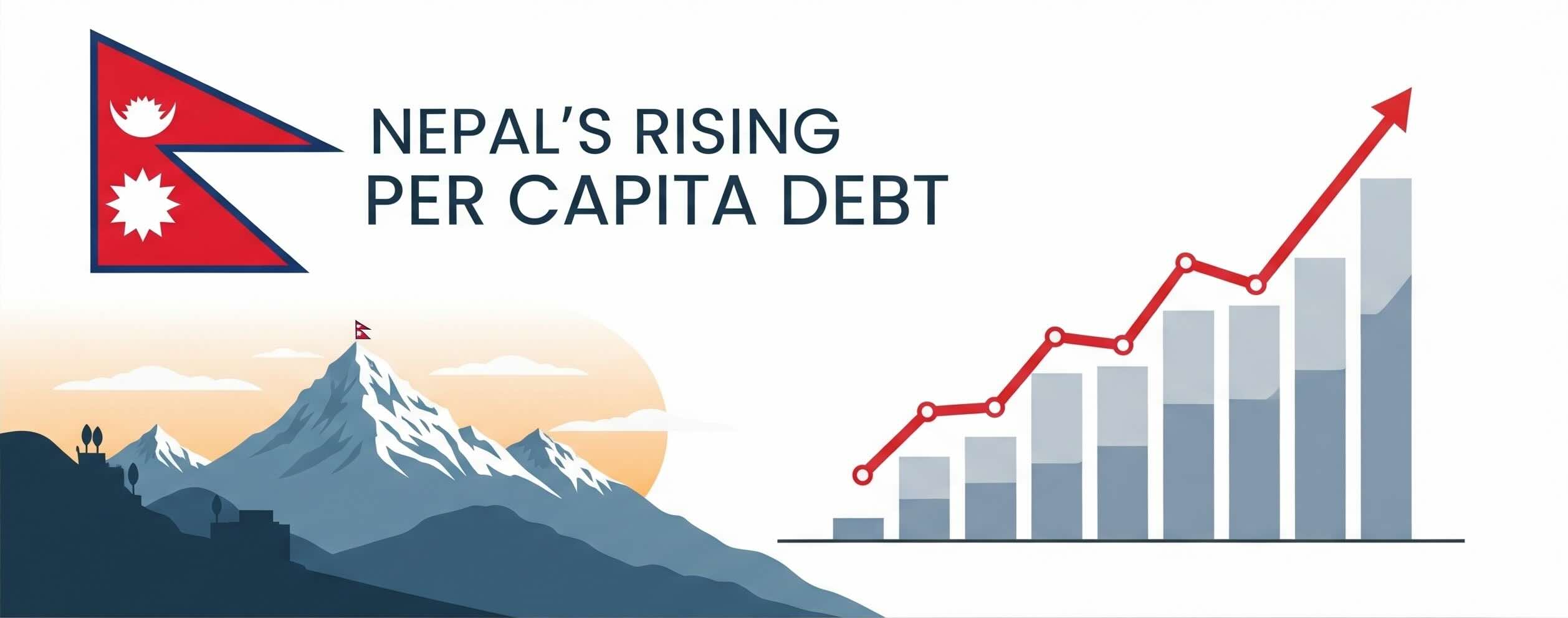A Tragic Seven-Fold Rise in Nepal's Per Capita Debt: A Federal Dream Turning into a Fiscal Nightmare
By Ashish Bhatta · ·

## Introduction
When Nepal adopted federalism in 2015 with the promulgation of a new constitution, it marked a historic transition from monarchy to a three-tiered democratic governance system. Hopes were high for decentralized development and improved service delivery. However, ten years later, the financial consequences have been devastating. Nepal's per capita debt has increased over seven-fold, outpacing not just its own economic growth but also the debt trajectories of its regional neighbors.
This article provides an analytical overview of Nepal's debt growth post-federalism, and contrasts it with how neighboring countries have managed their public debt more strategically.
---
## The Debt Explosion: A Quick Look at the Numbers
### Nepal: 2015 vs 2025
| Year | Total Public Debt | Population | Per Capita Debt |
|------|------------------|------------|-----------------|
| 2015 | Rs. 517 billion | ~28.5M | Rs. 18,140 |
| 2025 | Rs. 3.7 trillion | ~29.5M | Rs. 125,400 |
📉 Over 7x increase in per capita debt in a decade.
---
## Regional Comparison: How Do Nepal's Neighbors Use Debt?
| Country | Debt-to-GDP Ratio (2025 est.) | Per Capita Debt (USD) | Key Debt Usage |
|------------|------------------------------|----------------------|---------------------------------------------------|
| Nepal | ~49% | ~$980 | Administration, subsidies, project delays |
| India | ~84% | ~$2,300 | Infrastructure, defense, welfare |
| Bangladesh | ~38% | ~$800 | Export zones, energy, social safety nets |
| Bhutan | ~105% | ~$3,400 | Hydropower projects (revenue-generating) |
| Sri Lanka | ~122% | ~$4,000 | Borrowed heavily for vanity infrastructure (and defaulted) |
### Key Insights:
- India and Bangladesh have leveraged debt for productive investments—industrial corridors, renewable energy, export-oriented growth.
- Bhutan, despite a high debt-to-GDP ratio, uses debt for hydropower projects with long-term returns and bilateral repayment agreements (mostly with India).
- Sri Lanka, like Nepal, misused its debt for prestige infrastructure and unviable projects, eventually defaulting in 2022.
- Nepal, although with a moderate debt ratio, has seen very little productive return on its borrowing.
---
## Where Nepal Went Wrong
### 1. Federalism Without Fiscal Preparedness
Nepal's three-tier governance created:
- 7 provinces, 753 municipalities
- A massive increase in administrative spending (from Rs. 98B in 2015 to Rs. 360B+ in 2024)
- Over 80% of provincial and local budgets dependent on federal grants or loans
### 2. Borrowing for Recurring Costs
Unlike India or Bangladesh that finance infrastructure and export incentives, Nepal borrowed for:
- Salaries and office construction
- Vehicle purchases for officials
- Redundant bureaucracies
### 3. Low Capital Spending Efficiency
- Only 35–40% of capital budget is utilized annually
- Flagship projects like Melamchi Water Supply or Postal Highway face delays of 10+ years and massive cost overruns
---
## Impact on the People
- **Debt Servicing Soars**: Rs. 170B in FY 2024/25—6x more than in 2015
- **Tax Burden Grows**: VAT increased from 13% to 15%, excise on fuel, telecom, alcohol surged
- **Public Services Suffer**: Healthcare, education, and rural infrastructure lag behind due to rising fixed costs
---
## Comparative Usage of Borrowed Capital: Productive vs Unproductive
| Country | Productive Use of Debt | Unproductive Spending |
|------------|------------------------|-----------------------------------------------------------|
| Nepal | <35% | >65% on administration, delays, corruption |
| India | >60% | Minor leakages |
| Bangladesh | >70% | Targeted subsidies |
| Bhutan | ~80% | Some dependency risks |
| Sri Lanka | ~40% (pre-crisis) | White elephants, port loans, Chinese debt traps |
---
## What Nepal Can Learn and Do
### ✅ From Bangladesh & Bhutan
- Borrow only for high-yield projects (e.g., hydro, exports, logistics)
- Ensure strong repayment frameworks
### ✅ From India
- Build fiscal institutions that track efficiency and plug leakages
- Prioritize infrastructure that enhances productivity
### ❌ Avoid Sri Lanka's Path
- Curb prestige spending and politically driven projects
- Avoid unsustainable external borrowing, especially with opaque terms
---
## Recommendations for Nepal's Course Correction
1. **Introduce a Debt Ceiling Law**: Like India's Fiscal Responsibility and Budget Management (FRBM) Act
2. **Audit All Major Projects**: Independent audits of all loan-financed infrastructure
3. **Digital Transparency**: Real-time project dashboards open to the public
4. **Tie Loans to Revenue Generation**: Ensure that projects financed by debt have measurable returns
5. **Reduce Redundancy in Federal Structure**: Downsize overlapping roles between federal, provincial, and local tiers
---
## Conclusion
Nepal's dream of federalism is being undermined by a harsh economic reality: a per capita debt increase from Rs. 18,000 to Rs. 125,000 in a decade. While neighboring countries have often used debt as a tool for transformation, Nepal has used it—largely—for bureaucracy and political patronage.
Unless Nepal urgently reforms its fiscal strategy, it risks becoming another cautionary tale of how mismanaged governance can erode both public trust and economic sovereignty.
